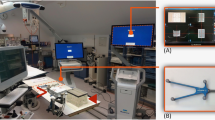Abstract
Purpose
To describe the features of a novel patient-mounted system for CT-guided needle navigation, the Puncture Cube System (PCS), and to evaluate the accuracy and efficiency of the PCS by (a) applying numerical simulations and (b) by conducting punctures using the system in comparison to punctures using the free-hand method (FHM).
Methods
The PCS consists of a self-adhesive cube that is attached to the patient, with multiple through-holes in the upper and lower template plate and dedicated software that, using a computer vision algorithm, recognizes the cube in a planning scan. The target in the image dataset is connected by a line, here “virtual needle,” which passes through the cube. For any chosen path of the virtual needle, the entry points for the needle into the cube are displayed by the software for the upper and lower template on-the-fly.
The possible exactness of the system was investigated by using numerical simulations. Next, 72 punctures were performed by 6 interventionists using a phantom to compare for accuracy, time requirement, and number of CT scans for punctures with the system to the FHM ex vivo (phantom study).
Results
The theoretical precision to arrive at targets increased with the distance of the target but remained low. The mean error for targets up to 20 cm below the lower plate was computed to be well below 0.5 mm, and the worst-case error stayed below 1.3 mm.
Compared to a conventional free-hand procedure, the use of the navigation system resulted in a statistically significantly improved accuracy (3.4 mm ± 2.3 mm versus FHM 4.9 mm ± 3.2 mm) and overall lower intervention time (168 s ± 28.5 s versus FHM 200 s ± 44.8 s). Furthermore, the number of CT scans was reduced to 2.3 versus FHM 2.8).
Conclusion
The PCS is a promising technique to improve accuracy and reduce intervention time in CT-guided needle navigations compared to the FHM.




Similar content being viewed by others
References
Deml M, Buhr M, D Wimmer M et al (2015) CT-guided infiltration saves surgical intervention and fastens return to work compared to anatomical landmark-guided infiltration in patients with lumbosciatica. Eur J Orthop Surg Traumatol 25:177–182. https://doi.org/10.1007/s00590-015-1602-9
Begemann PG (2009) CT-guided interventions—indications, technique, pitfalls. In: Mahnken AH, Ricke J (eds) CT- and MR-guided interventions in radiology. Springer Berlin Heidelberg, Berlin, pp 11–20
Hoeltje J, Bruening R, Kastler B et al (2013) Interventional pain managment. In: Mahnken AH, Wilhelm KE, Ricke J (eds) CT- and MR-guided interventions in radiology. Springer Berlin Heidelberg, Berlin, pp 363–419
Fritz J, Sequeiros RB, Carrino JA (2011) Magnetic resonance imaging–guided spine injections. Top Magn Reson Imaging 22(4):143–151. https://doi.org/10.1097/RMR.0b013e31827e5de1
Streitparth F, de Bucourt M, Hartwig T et al (2013) Real-time MR-guided lumbosacral periradicular injection therapy using an open 1.0-T MRI system: an outcome study. Investig Radiol 48(6):471–476. https://doi.org/10.1097/RLI.0b013e31828362be
Loizides A, Peer S, Plaikner M et al (2011) Ultrasound-guided injections in the lumbar spine. Med Ultrason 13(1):54–58
Roberts CC, Morrison WB, Deely DM, Zoga AC, Koulouris G, Winalski CS (2007) Use of a novel percutaneous biopsy localization device: initial musculoskeletal experience. Skelet Radiol 36(1):53–57. https://doi.org/10.1007/s00256-006-0182-5
CIVCO Medical Solutions. http://www.civco.com/mmi/ultrasound/computed-tomography/needle-guide/radguide-610-1187.htm. Accessed 11 Apr 2017
von Jako CR, Zuk Y, Zur O et al (2013) A novel accurate minioptical tracking system for percutaneous needle placement. IEEE Trans Biomed Eng 60(8):2222–2225. https://doi.org/10.1109/TBME.2013.2251883
Schubert T, Jacob AL, Pansini M, Liu D, Gutzeit A, Kos S (2013) CT-guided interventions using a free-hand, optical tracking system: initial clinical experience. Cardiovasc Intervent Radiol 36(4):1055–1062. https://doi.org/10.1007/s00270-012-0527-5
Putzer D, Arco D, Schamberger B, Schanda F, Mahlknecht J, Widmann G, Schullian P, Jaschke W, Bale R (2016) Comparison of two electromagnetic navigation systems for CT-guided punctures: a phantom study (Elektromagnetische Navigationssysteme im Vergleich: CT-gezielte Punktionen an einem phantom). Rofo 188(5):470–478. https://doi.org/10.1055/s-0042-103691
Durand P, Moreau-Gaudry A, Silvent A-S, Frandon J, Chipon E, Médici M, Bricault I (2017) Computer assisted electromagnetic navigation improves accuracy in computed tomography guided interventions: a prospective randomized clinical trial. PLoS One 12(3):e0173751. https://doi.org/10.1371/journal.pone.0173751
Gruber-Rouh T, Schulz B, Eichler K, Naguib NNN, Vogl TJ, Zangos S (2015) Radiation dose and quickness of needle CT-interventions using a laser navigation system (LNS) compared with conventional method. Eur J Radiol 84(10):1976–1980. https://doi.org/10.1016/j.ejrad.2015.07.004
Kettenbach J, Kronreif G (2015) Robotic systems for percutaneous needle-guided interventions. Minim Invasive Ther Allied Technol 24(1):45–53. https://doi.org/10.3109/13645706.2014.977299
Chehab MA, Brinjikji W, Copelan A, Venkatesan A (2015) Navigational tools for interventional radiology and interventional oncology applications. Semin Interv Radiol 32(4):416–427. https://doi.org/10.1055/s-0035-1564705
Beyer LP, Wiggermann P (2017) Planning and guidance: new tools to enhance the human skills in interventional oncology. Diagn Interv Imaging 98(9):583–588. https://doi.org/10.1016/j.diii.2017.07.004
Author information
Authors and Affiliations
Corresponding author
Ethics declarations
Funding
No funding was received for this study.
Conflict of interest
RH and SW are shareholders of Medical Templates AG.
Ethical approval
All procedures performed in the studies involving human participants were in accordance with the ethical standards of the institutional and/or national research committee and with the 1964 Helsinki Declaration and its later amendments or comparable ethical standards.
Informed consent
Informed consent was obtained from all individual participants included in the study.
Rights and permissions
About this article
Cite this article
Mokry, A., Willmitzer, F., Hostettler, R. et al. Evaluation of a novel, patient-mounted system for CT-guided needle navigation—an ex vivo study. Neuroradiology 61, 55–61 (2019). https://doi.org/10.1007/s00234-018-2107-0
Received:
Accepted:
Published:
Issue Date:
DOI: https://doi.org/10.1007/s00234-018-2107-0




